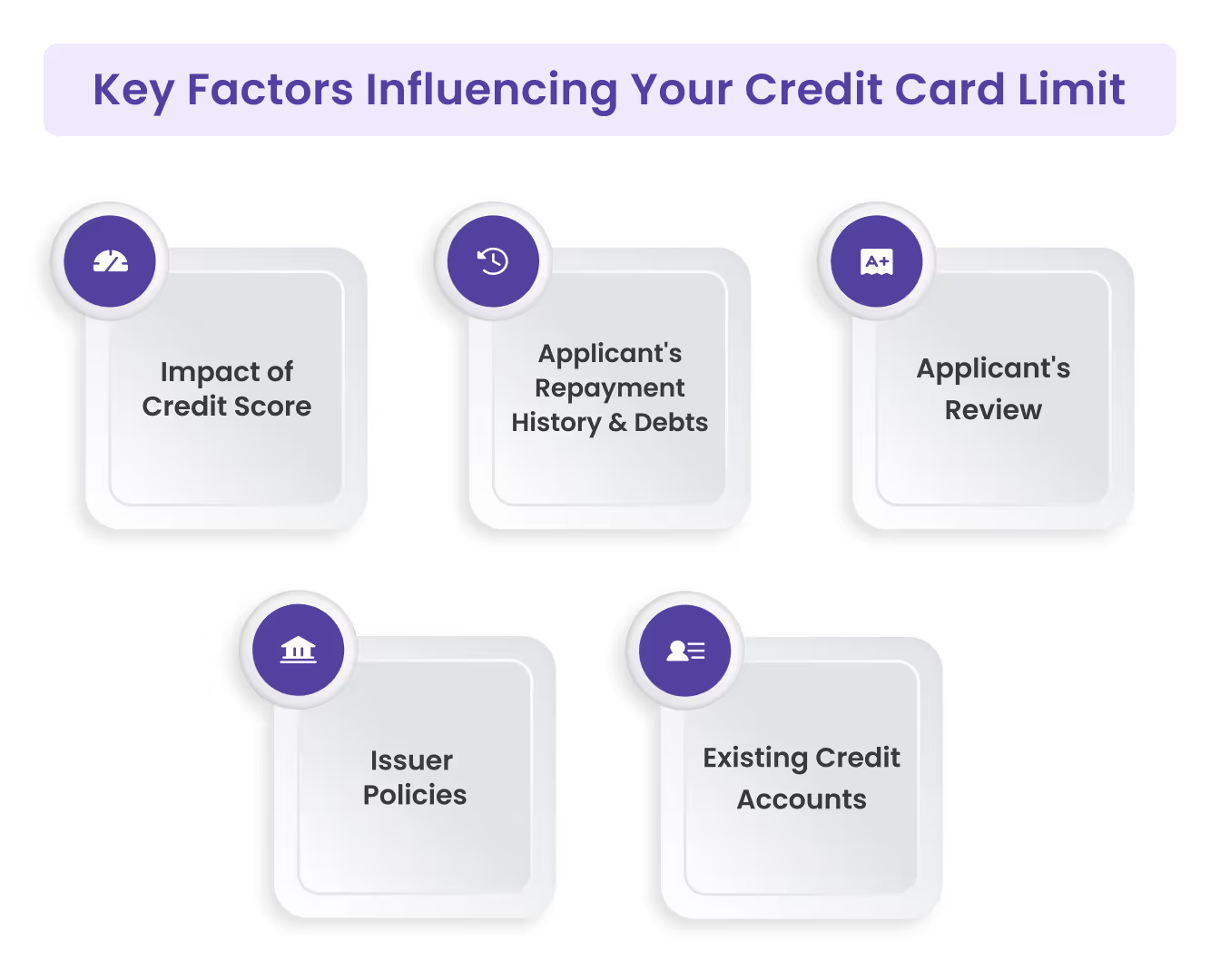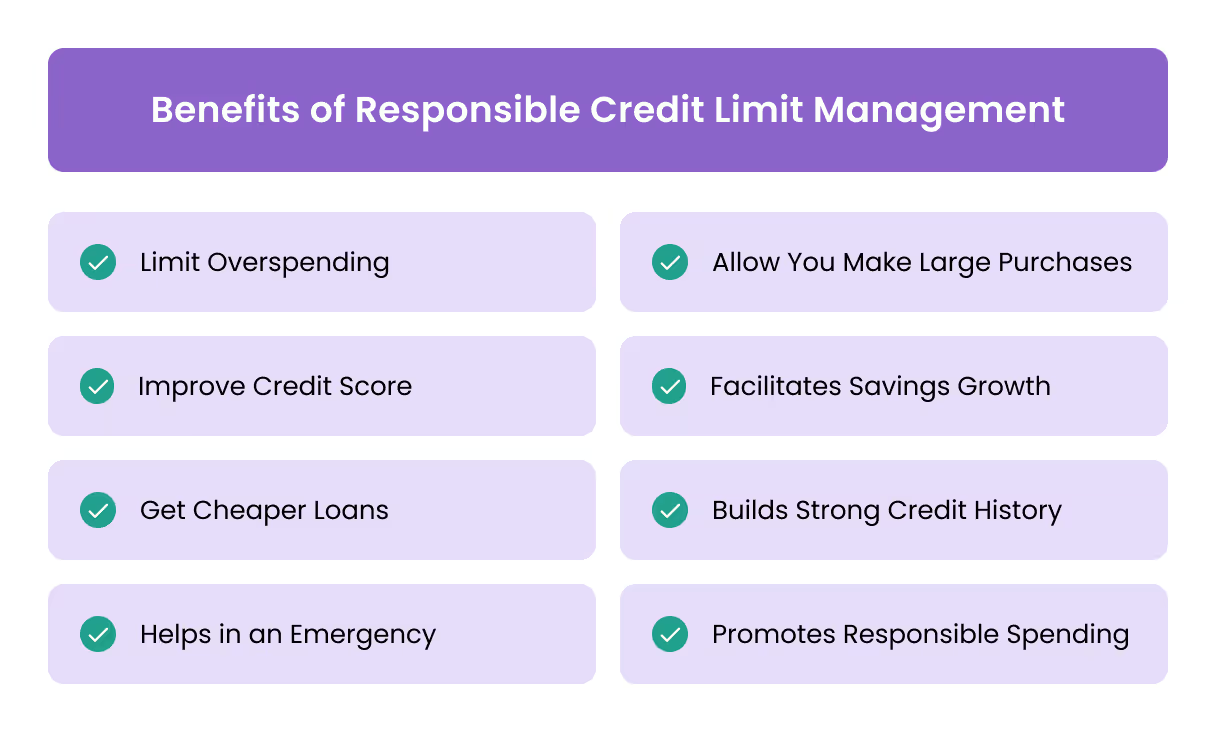Navigating the world of credit cards can be overwhelming, especially when determining your credit card spending limit. Setting an appropriate spending limit is essential for managing your finances and avoiding debt. In the UAE, a staggering 70% of credit cardholders need help with debt, often due to exceeding their credit limits or mismanaging their spending.
With the rising cost of living, understanding your credit card spending limit is more important than ever. By evaluating your income, expenses, and financial goals, you can set a limit that protects your credit score and enhances your purchasing power without the stress of overspending.
Thus, the article today will focus on understanding credit card spending limits, key factors influencing your credit card limit, the role of credit utilisation, the impact of payment history on credit limit, steps to improve chances of a higher credit limit, managing your current credit card usage, advantages of a responsible credit limit management, and how effective handing of credit usage can lead to financial benefits and improved credit opportunities.
Understanding Credit Card Spending Limits
To learn more about card spending limits, we’ll explain a credit card limit and its potential penalties.
- Credit Card Limit: The credit card limit is the maximum amount that cardholders can charge to their credit card. This includes all transactions, such as purchases, cash advances, and applicable fees. Establishing a credit limit is important in managing finances, as it helps consumers control their spending and avoid debt accumulation. A well-defined credit limit can help consumers maintain healthier financial habits.
- Potential Penalties: Exceeding your credit limit can lead to various negative consequences. These may include over-limit fees, increased interest rates, and a potential negative impact on your credit score. For example, if a cardholder exceeds their limit, they may be charged an over-limit fee ranging from AED 100 to AED 300, depending on the card issuer. Also, frequent over-limit usage can lead to a decreased credit score, making it more challenging to secure future credit.
[cta-1]
Key Factors Influencing Your Credit Card Limit

1. Impact of Credit Score, Income, and Existing Credit Balances
Your credit score significantly affects your credit card limit, as a higher score indicates a lower risk to lenders. Also, your income provides insight into your financial stability and ability to repay debt. Lenders even consider your existing credit balances; if you're close to your limits on other cards, it may raise concerns about your overall credit management.
2. Applicant's Repayment History, Existing Debts, and Credit Inquiries
Lenders will look closely at your repayment history, including how consistently you've made timely payments. A strong repayment record can enhance your chances of getting a higher limit. Existing debts are evaluated through your debt-to-income ratio, which shows how much of your income is already committed to debt repayment. Frequent credit inquiries can signal financial strain, possibly leading to lower limits.
- Debt-to-income: This ratio compares monthly debt payments to gross monthly income. A lower debt-to-income ratio indicates better financial health, making you a more attractive candidate for a higher credit limit.
- Credit History: Credit history influences your credit limit, including how long you've had credit accounts and your payment history. A longer history of on-time payments can result in higher limits. Conversely, a history of missed payments can lead to lower limits or denial of credit.
[cta-2]
3. Applicant's Review Based on Income and Obligations
Lenders assess your ability to manage additional credit by reviewing your income against your monthly obligations. This analysis helps them determine if you can handle more debt responsibly. A favourable debt-to-income ratio generally indicates that you can manage your financial commitments, leading to a potentially higher credit limit.
4. Issuer Policies
Different credit card issuers have varying policies when it comes to setting credit limits. Some issuers may offer higher limits to attract customers, aiming to provide competitive advantages. Conversely, others may take a more conservative stance, assessing the borrower's overall risk profile before determining appropriate credit limits. This approach ensures that they minimise the risk of default while balancing their desire to extend credit.
5. Existing Credit Accounts
Lenders may be more cautious about extending additional credit if you have existing credit accounts with high limits, especially if you maintain high balances. This is because high balances can indicate that you are potentially over-leveraged, which poses a higher risk to issuers. Demonstrating responsible credit use, such as timely payments and low balances, can improve your chances of receiving additional credit in the future
Role of Credit Utilisation
The significance of credit utilisation in credit card spending limit is based on your credit utilisation ratio. The credit utilisation ratio measures how much of your total available credit is currently being used and is an essential factor in determining your credit score.
To boost your score, aim to lower this ratio; however, avoid closing credit card accounts, as doing so can negatively impact your ratio. Keeping cards open helps maintain a higher overall credit limit, which benefits your credit health. The credit utilisation can significantly influence lenders' perceptions of your creditworthiness. Here are the key aspects of credit utilisation:
- High Credit Usage as a Warning Sign to Issuers: When a borrower has a high credit usage rate, it can signal financial distress to lenders. High usage indicates that the borrower relies heavily on credit, which may raise concerns about their ability to manage debt responsibly. It can lead issuers to be more cautious when considering additional credit extensions, potentially resulting in lower credit limits or even account reviews.
- Ideal Credit Utilisation Ratio: The ideal credit utilisation ratio is usually recommended to be less than 30%, meaning you should use at most 30% of your total available credit. However, best practices suggest keeping utilisation below 7% for optimal credit health. Maintaining a low utilisation rate demonstrates responsible credit management, positively influencing credit scores and making you a more attractive candidate for higher credit limits in the future.
After reviewing the significance of credit utilisation, you can look at how payment history affects your credit limit.
[cta-3]
Impact of Payment History on Credit Limit
Your credit limit is affected by payment history on the following parameters:
Positive Payment History Improves Credit Limit Opportunities
Maintaining a positive payment history is vital for increasing your chances of obtaining higher credit limits. Lenders view on-time payments as an indicator of responsible borrowing behaviour, which can enhance your creditworthiness. A solid payment record can positively impact your credit score, making you more appealing to lenders for credit limit increases.
Late Payments is Equal to Higher Limit
Late payments can significantly harm your credit limit prospects. A history of missed or delayed payments can lower your credit score and create doubt about your ability to manage debt. This negative impact may deter lenders from granting higher credit limits or could lead to reductions in your existing limits.
How To Increase Your Credit Card Limit?
Credit cards are vital financial tools today, providing convenience, security, and potential rewards for everyday spending. A key element of responsible credit card management is maintaining a healthy credit limit—the maximum amount you can borrow on your card.
You can often increase your credit limit by actively managing your credit habits. A sufficient limit offers flexibility and helps keep your credit utilisation ratio low, which benefits your credit score.
Here, you’ll find strategies for increasing your credit card limits, which will ultimately help you enhance your financial health.
Understanding Credit Limit Increases
Before seeking ways to enhance your credit limit, it's essential to understand how credit card companies evaluate requests for increases.
- Creditworthiness Assessment: Credit card issuers assess various factors to gauge your creditworthiness, including your credit score, income, employment stability, debt-to-income ratio, and history with their cards. A high credit score and effective credit management practices improve your chances of securing a limit increase.
- Pre-approved Offers: Many card issuers provide pre-approved offers for credit limit increases based on your creditworthiness. To see if you qualify for these offers, check your online account, email notifications, or physical mail from your issuer.
💡Tip: “To increase your credit limit, simply visit your issuer's mobile app or website to request an increase online, then wait for their response regarding your application.”
Steps to Improve Chances of a Higher Credit Limit

1. Review and Correct Errors in the Credit Profile
Start by checking your credit report for any inaccuracies or errors. Mistakes in your credit profile can negatively impact your credit score, affecting your eligibility for a higher credit limit. You can dispute any discrepancies with credit reporting agencies to ensure your information is accurate and up-to-date. Regularly monitoring your credit report is a good practice to catch errors early.
2. Refinance Your Credit Card Debt
If you are overwhelmed by credit card debt, consider refinancing through it. By consolidating your credit card debt into a personal loan, you can potentially lower your debt utilisation ratio to zero, simplifying your financial management.
However, using this strategy wisely is important to avoid further overspending on credit cards after refinancing. Maintaining a disciplined approach to your spending will help prevent the accumulation of additional debt.
3. Ensure Timely Payments
Consistently making on-time payments is crucial for building a positive payment history, which lenders value highly when considering credit limit increases. Additionally, reducing your outstanding balances can lower your credit utilisation ratio, positively influencing your credit score. Aim to keep your credit utilisation ratio below 30%, or even better, below 7%, for optimal credit health.
4. Contact Card Issuer
One effective way to request a credit limit increase is by contacting your card issuer directly through their customer service number or online chat support. During the conversation, clearly express your desire for an increase while highlighting your positive credit history and responsible credit utilisation.
5. Review Credit Line
Some issuers automatically offer credit line reviews at regular intervals. This means you might not need to submit a formal request, as they could evaluate your account for a limit increase based on your credit profile and payment history.
If you know a trusted family member or friend with a high-limit credit card, ask them to add you as an authorised user. This can increase your available credit line and positively impact your credit report without requiring you to spend anything. Ensure that the primary cardholder pays their bills on time, as their habits will directly affect your credit score.
[cta-4]
6. Apply for a New Card with a Higher Limit
If your card issuer is in no mood to increase your credit limit, consider applying for a new card from a different issuer offering a higher limit. Before closing your existing account, ensure you receive approval for the new card, as closing accounts can negatively impact your credit score.
Manage Your Current Credit Card Usage
Effectively managing your credit card usage is essential for maintaining a healthy credit score and ensuring financial stability. Here are some practical strategies to help you manage your credit card usage:
1. Monitor Your Spending
Check your transactions regularly to stay aware of your spending habits. Many credit card issuers, provide tools and alerts to help you track your expenses in real-time. This notification process makes it easier to adhere to your budget and adjust your spending habits as needed.
You can even develop good spending habits by regularly reviewing your credit card activity to identify trends in overspending and adjust accordingly. You can make top-notch financial decisions and stay on track by assessing your monthly expenses.
2. Set a Budget
Establish a monthly budget that includes your credit card expenditures. This will help you avoid overspending and keep your finances on track. Aim to stick to this budget to maintain financial discipline.
3. Pay Your Balance in Full
Whenever possible, pay off your balance each month to avoid interest charges and keep your credit utilisation ratio low. This practice saves you money and positively impacts your credit score.
4. Use Automated Payments
Consider setting up automatic payments for at least the minimum amount due. This ensures you never miss a payment, which can lead to late fees and negatively affect your credit score.
The ability to transfer funds quickly has been incredibly beneficial for one of Alaan's clients, Smart Zone, as it allows them to handle payments efficiently on behalf of their clients.
5. Set a Personal Spending Cap
By establishing a personal spending limit, you can effectively control your credit utilisation, helping to prevent overspending and maintain a healthy credit score. Aim to keep your credit utilisation below 30% of your total credit limit. This ratio is a significant factor in your credit score calculation, so managing it wisely can improve your credit health.
6. Use Cashbacks and Rewards
With cashback and rewards features, you can earn while spending and redeem points toward expenses, like reducing your balance as a statement credit. Take full advantage of these rewards by regularly redeeming them for available options to maximise your benefits.
7. Consolidated Debt
If managing multiple credit card payments is sometimes unmanageable, consolidating your debt could be the solution. You can transfer balances to a single credit card or opt for a debt consolidation loan. By consolidating, especially with a card offering a lower introductory APR, you can streamline payments and potentially reduce your overall interest burden.
8. Review Your Statements
Take the time to review your monthly statements for errors or unauthorised transactions. Reporting these issues promptly can help prevent financial loss and maintain credit integrity.
Advantages of a Responsible Credit Limit Management
A major advantage of credit management is gaining a comprehensive view of your company’s financial health, helping you minimise unnecessary credit risks while capitalising on growth opportunities.
However, the benefits of credit line management also include the following:
Benefits of Responsible Credit Limit Management

- Limit Overspending: By keeping track of your credit limit, you can prevent yourself from overspending and accumulating unnecessary debt.
- Improve Credit Score: Responsible credit limit usage helps maintain a low credit utilisation ratio, which positively impacts your credit score.
- Get Cheaper Loans: A good credit score from responsible limit management can help you qualify for loans with lower interest rates.
- Helps in an Emergency: An available credit limit offers financial flexibility during unexpected situations or emergencies.
- Allow You Make Large Purchases: A well-managed credit limit allows you to make larger purchases when needed without hurting your credit standing.
- Facilitates Savings Growth: By avoiding debt and high-interest payments, you can focus on saving money for future goals.
- Builds Strong Credit History: Responsible credit management consistently helps establish a solid credit history, which benefits future financial opportunities.
- Promotes Responsible Spending: It encourages realistic spending habits while maintaining low credit utilisation, which supports long-term financial health.
This approach helps in balancing financial flexibility with stability.
[cta-5]
Conclusion
Understanding and managing your credit card spending limits involves personal factors and issuer-specific criteria. With the Alaan Business Credit Card, you can effectively handle your credit usage, unlock significant financial benefits and enhance your credit opportunities.
Check out Alaan visa card benefits! Schedule a demo to know more.


.avif)







